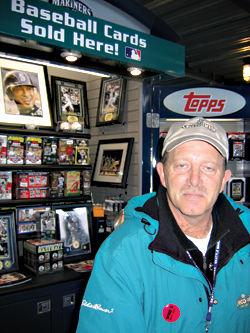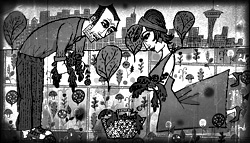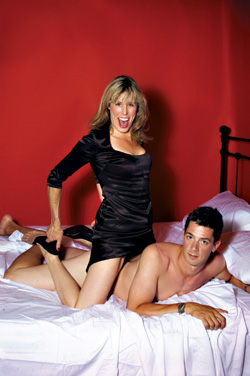A few minutes before the first pitch of the Seattle Mariners’ recent home stand against the Minnesota Twins, a brown-haired boy appears at Walter Keith’s baseball card kiosk near Safeco Field’s home plate entrance. “Do you have any baseball cards?” he blurts, perhaps too short to read the “Baseball Cards Sold Here!” emblazoned on all sides of the booth.
Keith, framed by the packs, boxes, and sets of trading cards displayed on the counter and shelves, looks down and smiles. “I have a whole bunch,” he says. He reaches behind a display case, pulls out about a dozen loose cards, and hands them to the kid. “Here you go.”
The boy’s eyes widen. “You mean I can have them?”
“Yep.”
“Sweet!” Beaming, he runs to show off his haul to his friends.
The boy is too shy to give his name, but his friends are not. Christian Conn, 8, presents a thick stack of cards that he’s harvested from Safeco ushers and souvenir stands. “I’m a baseball card collector,” he declares. “I just started.”
Just two seasons ago, this scene could not have taken place. Not only did Keith’s kiosk not exist, none of the souvenir stands carried much in the way of baseball cards. Incongruous as it seems, for years, one of the most difficult things to find at Safeco—or any Major League Baseball stadium—was a pack of baseball cards.
But in 2006, as part of MLB’s new and exhaustive plan to reintroduce its fans to baseball cards, the league piloted card kiosks at about a half-dozen ballparks, including Safeco. Keith’s stand, then located in center field near the children’s play area, was the league’s top performer, and Mariners novelty buyer Shawn Wert says the ballpark sold about 28,000 total packs for the year. This season, MLB has expanded the kiosks to all 30 of its stadiums.
“Most people probably didn’t know that cards weren’t in the ballparks,” says Daryl McKay, president of Sports Images, a Massachusetts-based card-and-memorabilia wholesaler that stocks the card kiosks at each MLB stadium. “We have people coming up to us now and saying, ‘I didn’t know they still made cards.'”
That baseball fans weren’t even aware enough of baseball cards to look for them at the ballpark speaks to just how far the hobby had fallen from its zenith in the late 1980s. Back then, baseball cards were the darlings of the collectibles industry. A 1987 Time magazine story proclaimed them an “outlandish but sound investment,” and even suggested that trading cards were more lucrative than the stock market. The hobby’s popularity led to an explosion of card makers and card sets, which confused collectors and flooded the market with cards that it couldn’t absorb. The irrational exuberance of the times drove up the cost of entry, disillusioning traditional collectors and pricing out kids. “I felt so bad when I was selling a pack of three cards for $18,” says Keith, who also owns a card shop in Montlake.
The gains in value that cards could make attracted a new kind of collector: the investor. “That was good in terms of getting foot traffic in the store, but it promoted a culture of people looking at it just from a money standpoint,” says Pete Brown, owner of Brown’s Cooperstown card shop in Fremont. “What’s going to go up, when it’d pay off . . . it was a mini–stock market.”
Those who weren’t hoarding unopened cases were tearing into boxes in search of rare inserts. Almost as quickly as they had bought in, investors realized that their returns couldn’t continue, and people who didn’t cash out were left with cards worth pennies on the dollar. The baseball strike of 1994 further crippled the hobby, souring even loyal collectors. And the number of card stores in the Northwest serviced by Talkin’ Sports, a distributor with a warehouse in Everett, fell by half. Many shops resorted to Beanie Babies and Pokémon cards just to survive.
But the Mark McGwire and Sammy Sosa home-run race helped restore baseball’s relevance, priming Seattle for what Brown calls the “near-perfect season of 2001.” That year, Ichiro Suzuki broke in as a rookie, Safeco hosted the All-Star Game, and the Mariners tied the MLB record of 116 wins in a season. The Mariners were so hot that Brown had almost as much difficulty satisfying customers’ requests for journeyman outfielder Charles Gipson’s card as for Ichiro’s, as fans sought a complete team set. “The interest we got in stores was absolutely phenomenal,” Brown recalls. “But it was a very different type of collecting than had gone on even a couple of years before.”
Though the industry had stabilized, it was still overcrowded, and neither collectors nor concessionaires knew which cards to collect, so Safeco only offered team sets. Individual packs—to say nothing of boxes or sets—remained as rare as triple plays. Eventually, MLB decided that one of its most important points of entry for fans had been dammed for too long. So instead of waiting for the market to sort out the winners, as in the case of the dot-com boom, MLB decided to do the sorting itself.
Before the 2006 season, MLB announced that it would limit its baseball card licenses to two companies: Topps and Upper Deck. It also standardized rookie cards, to cut down on speculation and to time the release of a rookie card with the player’s actual rookie season. And then it drafted a licensing agreement that made all involved entities—MLB, Topps, Upper Deck, and the MLB Players Association—commit to investing in the promotion and advertising of baseball cards on an unprecedented scale, including MLB’s first-ever television campaign. To help ballparks navigate the market, MLB brought on Sports Images as its distributor. “MLB’s really trying to grow this area of business, trying to get kids back into collecting,” says Wert.
This season, the Mariners moved Keith from center field to the home-plate entrance, and in just nine games, he says he’s already months ahead of his 2006 pace. According to Wert, the Mariners plan to open a second kiosk, back in center field, to begin offering single cards of Mariners past and present, and to increase the number of card events, all of which will be supported by the league. In keeping with the industry’s newfound emphasis on fun, Safeco’s card kiosk doesn’t carry price guides, and Wert makes sure to stock packs that kids can afford. “Yes, cards have investment potential, but we want to bring their entertainment value back,” says McKay. “Opening that pack, rifling through it for the first time, not knowing what might be in there—there’s nothing like it.”
Outside the ballpark, Brown has noticed increasing numbers of young customers in his store who are interested in baseball cards as connections to the game rather than as cash cows, which he attributes directly to MLB’s taking charge of the hobby. Last week, Brown had a couple of young boys browse though his displays and finally decide on a 1988 Donruss set and 1989 Fleer set (two wildly overproduced, practically worthless sets). Their parents suggested they buy something more recent, but the kids knew what they wanted. “These have 800 cards for only $10,” they explained, as if the cost-benefit analysis was obvious.
“This year so far has been the best since 2001,” says Brown. “It’d help if the Mariners went on a tear, though.”








